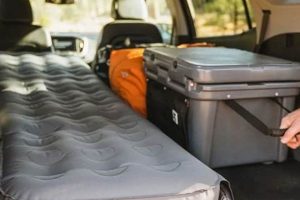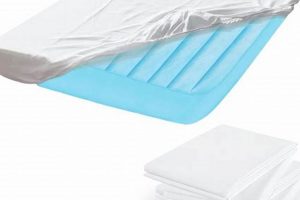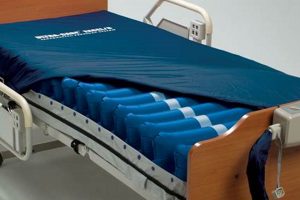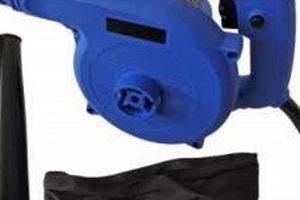Locating the source of air leakage in inflatable mattresses is a process of identifying compromised areas in the material that allow air to escape. This identification often involves methods that visually or audibly detect the escaping air, or physically sense it using water or soapy solutions. For instance, observing bubbles forming on a mattress surface covered with soapy water indicates the presence of a puncture.
Pinpointing these leaks is crucial for maintaining the functionality and lifespan of air mattresses. A mattress that consistently deflates provides inadequate support, impacting sleep quality and comfort. Addressing these issues promptly prevents further damage to the mattress and avoids the cost of replacement. Historically, methods for leak detection have evolved from simple auditory checks to the use of specialized sprays and electronic detectors.
Several techniques exist for achieving effective detection of these leaks. Visual inspection, auditory assessment, soapy water application, and specialized detection equipment offer varied approaches. A detailed examination of these methods provides a practical guide for resolving issues of air leakage in inflatable mattresses.
Locating Air Leaks
Efficient leak detection in air mattresses requires a systematic approach. The following tips provide a structured method for identifying and addressing air leaks:
Tip 1: Conduct a Visual Inspection: Prior to any other method, examine the mattress surface for obvious punctures, tears, or areas of wear. Pay particular attention to seams and areas around the inflation valve.
Tip 2: Employ Auditory Detection: In a quiet environment, inflate the mattress fully and listen closely for hissing sounds. Move around the mattress, concentrating on areas where leaks are suspected.
Tip 3: Utilize Soapy Water: Mix a small amount of mild dish soap with water in a spray bottle. Apply the solution to sections of the inflated mattress. Bubbles forming indicate a leak’s location.
Tip 4: Submerge in Water (if feasible): For smaller air mattresses, submerging sections in a tub of water can reveal leaks. Observe for streams of bubbles emanating from the mattress.
Tip 5: Focus on Seams and Valves: These areas are common points of failure. Carefully inspect the seams for separation and the valve for proper closure and seal integrity.
Tip 6: Use a Damp Cloth for Large Mattresses: When submerging is impractical, a damp cloth can be used to wipe down sections of the mattress surface. The dampness may amplify the sound of escaping air.
Tip 7: Mark Identified Leaks: Once a leak is detected, use a marker or piece of tape to clearly indicate its location. This will facilitate the patching process.
The application of these techniques increases the likelihood of successfully pinpointing air leaks, allowing for timely repair and prolonged use of the air mattress.
Following leak detection, the appropriate repair method should be implemented to restore the mattress to its functional state.
1. Visual inspection first
The initial step in detecting air leaks involves a comprehensive visual assessment of the inflatable mattress. This preliminary examination provides a foundation for subsequent, more detailed inspection methods. Its efficiency hinges on a methodical approach and a keen eye for detail.
- Surface Anomalies
The primary focus is the detection of surface irregularities. These can manifest as cuts, tears, abrasions, or unusual wear patterns. For instance, a dark discoloration on the mattress surface might indicate a thinned area prone to puncture. The location and characteristics of these anomalies are documented to guide further investigation.
- Seam Integrity
Seams represent inherent weak points in the mattress construction. Visual inspection should scrutinize the seams for separation, fraying, or adhesive failure. A common example is the lifting of a seam weld due to stress or improper manufacturing. Observing such defects directs attention to potential leak sites along these seams.
- Valve Assessment
The inflation valve deserves particular attention. The valve housing is examined for cracks or breaks, and the valve seal is inspected for damage or debris. A misaligned or cracked valve can compromise the airtight seal, leading to gradual air loss. Ensuring the valve sits flush and operates smoothly is a crucial part of this visual stage.
- Foreign Object Detection
Embedded objects, such as splinters, thorns, or small pieces of debris, can penetrate the mattress material. A visual sweep identifies these foreign bodies, which often appear as tiny protrusions or discolorations. Removing these objects is essential to prevent further damage and facilitate effective patching.
By meticulously conducting a visual inspection, the likelihood of identifying significant leak sources is greatly increased. This initial assessment streamlines the leak detection process and allows for the efficient application of complementary techniques, such as auditory assessment and soapy water testing, ultimately guiding the repair strategy.
2. Auditory assessment critical
Auditory assessment represents a crucial technique for determining the location of air leaks in inflatable mattresses. This method relies on the ability to detect the sound of escaping air, offering a non-invasive means of identifying potential breach points within the mattress structure.
- Quiet Environment Requirement
The effectiveness of auditory assessment depends significantly on ambient noise levels. A silent environment maximizes the ability to discern the subtle hissing sound characteristic of air escaping through a small opening. In noisy environments, these sounds are easily masked, rendering auditory assessment unreliable. An example would be performing the assessment in a room with running machinery versus a quiet bedroom.
- Proximity and Positioning
The distance and orientation of the ear relative to the mattress surface influence the detectability of air leaks. Closer proximity increases the sound intensity, while strategic positioning may help isolate the leak sound from other ambient noises. For instance, placing an ear close to a seam while slowly moving along its length allows for focused listening and improved leak detection.
- Inflation Pressure Influence
The pressure within the inflated mattress directly correlates with the audibility of air leaks. A fully inflated mattress exhibits a higher pressure differential between the interior and exterior, resulting in a louder, mor
e easily detectable hissing sound. Conversely, a partially deflated mattress may produce a sound too faint to detect. The mattress must maintain adequate inflation for effective assessment. - Leak Size and Shape
The size and shape of the leak influence the characteristics of the emitted sound. Larger punctures produce a louder, more pronounced hissing, while smaller, pinhole leaks may generate a very faint, high-pitched sound. The geometry of the leak also affects sound propagation, with some leaks emitting a directional sound while others disperse more broadly. These differences impact the ease of detection using auditory methods.
These considerations underscore the importance of controlled conditions and careful technique when employing auditory assessment in the detection of air leaks. Successfully pinpointing the leak enables effective repairs and extends the lifespan of inflatable mattresses.
3. Soapy water solution
The utilization of a soapy water solution represents a practical and widely accessible method for detecting air leaks in inflatable mattresses. The principle underlying this technique involves the formation of bubbles at the point where escaping air interacts with the soapy film, thus visually indicating the leak’s location.
- Bubble Formation Mechanism
The solution’s effectiveness stems from the reduction of surface tension caused by the presence of soap. When applied to an inflated mattress, the soapy water spreads thinly across the surface. Air escaping through a hole forces its way through this film, causing bubbles to form. The size and persistence of the bubbles often correlate with the leak’s magnitude. A larger leak produces more numerous and longer-lasting bubbles compared to a pinhole.
- Solution Concentration and Application
The optimal concentration of the solution is crucial. Excessive soap can create an overly thick film that obscures small leaks, while insufficient soap results in weak, short-lived bubbles. Typically, a few drops of mild dish soap per cup of water provides an adequate concentration. Application is best achieved using a spray bottle, allowing for even distribution across the mattress surface. The solution should be applied in sections to prevent premature drying and maintain optimal bubble formation conditions.
- Visual Interpretation and Leak Identification
The appearance and behavior of the bubbles provide clues about the nature of the leak. Steady, consistent bubble formation indicates a sustained airflow and a relatively large leak. Intermittent or slow bubble formation suggests a smaller leak or a partially obstructed pathway. Observing the precise location of bubble formation allows for accurate marking of the leak’s source. This accuracy is essential for effective patching and repair efforts.
- Limitations and Alternative Approaches
While effective, the soapy water method has limitations. It may be less reliable in detecting leaks in heavily textured mattress surfaces or areas with significant dirt accumulation. Furthermore, it is generally unsuitable for use on mattresses with electronic components or sensitive materials. Alternative methods, such as auditory detection or specialized leak detection sprays, may be more appropriate in these situations. However, for most standard air mattresses, the soapy water solution provides a simple, cost-effective, and readily available diagnostic tool.
In summary, the strategic application of a carefully prepared soapy water solution offers a visual means of pinpointing air leaks. The insights gained from bubble formation, combined with an understanding of the solution’s limitations, enable informed decisions regarding repair procedures, ultimately preserving the utility and longevity of the inflatable mattress.
4. Seam integrity matters
The structural integrity of an air mattress’s seams is paramount in preventing air leakage. Compromised seams represent a frequent source of deflation, necessitating careful inspection to identify and address potential air leaks. The identification of weakened or damaged seams is a crucial step in maintaining the air-retention capabilities of the mattress.
- Adhesive Failure
Many air mattresses rely on adhesive bonding to join the fabric layers at the seams. Over time, these adhesives can degrade due to factors such as temperature fluctuations, humidity, and physical stress. A visual indication of adhesive failure includes separation of the seam layers, creating a pathway for air to escape. For example, a seam that appears to be peeling apart along its length is a prime candidate for leakage. The consequence is a gradual or rapid deflation of the mattress, impacting its usability.
- Weld Weakness
In some air mattresses, heat welding is employed to fuse the material layers. Imperfect welding processes or material degradation can result in weak or brittle weld points. These points are susceptible to cracking or separation under pressure, leading to air leakage. An example is a seam that shows signs of discoloration or deformation, indicating a compromised weld. Addressing weld weaknesses requires specialized repair techniques to ensure a durable and airtight seal.
- Material Fatigue
Repeated inflation and deflation cycles, coupled with the stress of supporting weight, can lead to material fatigue along the seams. This fatigue manifests as microscopic cracks or tears in the fabric, creating channels for air to escape. Visible signs of fatigue include creasing, stretching, or thinning of the material near the seams. The gradual nature of material fatigue often results in slow, insidious air loss that is difficult to detect. Regular inspection and maintenance can help mitigate the effects of material fatigue.
- Puncture Proximity
The area immediately surrounding a seam is often more vulnerable to punctures. This is due to the increased stress concentration at the seam and the potential for the material to be thinner or weaker in this region. A small puncture near a seam can quickly propagate along the seam line, creating a larger and more problematic leak. Therefore, close examination of the material adjacent to the seams is crucial during leak detection. Addressing punctures promptly and reinforcing the surrounding area can prevent further damage and maintain seam integrity.
In conclusion, maintaining the integrity of the air mattress’s seams is an ongoing process that requires vigilance and timely intervention. Addressing issues such as adhesive failure, weld weakness, material fatigue, and puncture proximity can significantly prolong the lifespan of the mattress and ensure reliable performance. The methods outlined for detecting leaks are essential for identifying compromised seams, enabling appropriate repairs and preventing further deflation.
5. Valve inspection crucial
The inspection of the air mattress valve forms an indispensable component of the process to locate air leaks. The valve, serving as the primary ent
ry and exit point for air, is a common location for failures resulting in deflation. A compromised valve renders the entire mattress unusable until the issue is resolved, directly linking its functionality to the success of any leak detection effort. The valve’s complex structure, involving multiple components like seals, stems, and housing, makes it susceptible to various types of damage. The valve’s critical role necessitates careful and methodical inspection as an integral element of the leak-finding process. For instance, a loose or cracked valve stem allows air to escape continuously, despite the absence of punctures elsewhere in the mattress.
Failure to properly inspect the valve can result in wasted effort in searching for leaks elsewhere on the mattress surface. Even with meticulous examination of the mattress body, a leaking valve will continue to cause deflation. This highlights the practical significance of starting the leak detection process with a thorough valve check. Furthermore, understanding the different types of valve failures such as a damaged seal preventing airtight closure or a fracture in the valve housing informs the specific techniques required for effective inspection. For example, a visual examination alone may not reveal a subtle leak in the valve seal, requiring the application of soapy water to detect escaping air.
The challenges associated with valve inspection often involve accessing and examining internal components. Specialized tools or techniques may be required to dismantle the valve assembly for a complete assessment. In summary, prioritizing valve inspection is not merely a preliminary step, but a critical element interwoven into the methodology of finding leaks. Overlooking the valve risks misdiagnosis and ineffective repair strategies, emphasizing the importance of diligent valve assessment in the broader process of maintaining the air mattress functionality.
6. Patch testing afterward
Verifying the efficacy of a patch applied to an air mattress constitutes an essential final step in the overall leak repair process. Successful patching restores the mattress to its intended functionality, while inadequate repairs negate previous detection efforts. Therefore, methodical patch testing directly relates to the initial objective of determining air leak locations.
- Pressure Retention Assessment
The primary goal of patch testing involves evaluating the repaired area’s ability to maintain air pressure over an extended period. A properly applied patch forms an airtight seal, preventing further air leakage. The mattress is inflated to its recommended pressure, and the pressure is monitored for several hours. Any pressure drop indicates a patch failure, signifying the need for either reapplication or alternative repair methods. For example, observing a significant deflation overnight suggests a faulty patch or a missed leak adjacent to the repaired area.
- Soapy Water Re-application
Following the application of a patch, the soapy water solution may be re-applied to the area surrounding the patch. This ensures that the patch itself is not leaking and that no additional leaks exist in close proximity. The appearance of new bubbles would indicate a failure of the adhesive bond or the presence of undiscovered damage. For instance, bubbles forming at the edge of the patch indicate a compromised seal that allows air to escape.
- Visual Inspection of Patch Adhesion
The integrity of the patch’s adhesion to the mattress material must be visually verified. A patch that is peeling, lifting, or exhibiting any signs of detachment is likely to fail and require replacement. The edges of the patch should be flush with the mattress surface and securely bonded. Furthermore, the presence of creases or air pockets beneath the patch suggests inadequate adhesion, potentially leading to future leaks. Examples would include patches exhibiting edge curling or the presence of visible air gaps.
- Stress Testing of Repaired Area
The patched area is subjected to controlled stress to evaluate its resilience. This involves applying moderate pressure to the patch and the surrounding material to simulate the weight distribution of a user. This stress test can reveal weaknesses in the patch or the underlying material that may not be apparent under normal conditions. Observation of the patch’s reaction to pressure, such as bulging or deformation, provides insights into its ability to withstand long-term use. An example includes observing the patch for stretching or detachment when weight is applied directly above it.
Successful completion of the aforementioned patch testing protocols confirms the efficacy of the leak repair. A mattress that demonstrates sustained pressure, secure patch adhesion, and resistance to stress testing is deemed adequately repaired. Conversely, any failure during testing necessitates a re-evaluation of the patching technique or a more thorough search for additional leaks. Ultimately, rigorous patch testing ensures the long-term functionality of the air mattress and justifies the initial effort expended in detecting and addressing the air leak.
7. Consider submersion option
The consideration of submerging an air mattress as a leak detection method arises within the context of identifying air leaks, primarily applicable to smaller, more manageable inflatable products. Submersion provides a highly visual means of pinpointing the source of escaping air, but its feasibility depends on the size and construction of the mattress.
- Suitability and Size Constraints
The submersion technique is most effective with smaller air mattresses due to logistical constraints. The requirement for a sufficiently large water container to fully or partially submerge the mattress limits its application to readily manageable sizes. For example, a standard-sized twin air mattress may be suitable for submersion in a bathtub or large trough, while larger queen or king-sized mattresses present significant challenges in finding appropriate submersion vessels. The size of the mattress directly dictates the practicality of this method.
- Visual Identification of Leaks
When an inflated air mattress is submerged in water, escaping air manifests as a stream of bubbles emanating from the leak location. This visual indication provides a clear and direct method for pinpointing the source of the leak. The steady stream of bubbles contrasts sharply against the surrounding water, simplifying the identification process, particularly for small or subtle leaks that may be difficult to detect using other methods. An example is observing a consistent stream of fine bubbles originating from a pinhole puncture, effectively revealing its presence.
- Material Compatibility and Water Immersion
Prior to submersion, assessing the mattress material’s compatibility with water is crucial. Some mattresses incorporate materials or coatings that may be susceptible to water damage or degradation. Prolonged submersion could exacerbate existing damage or introduce new issues. For instance, certain flocked surfaces may retain water, leading to mold or mildew growth. The composition of the mattress material dictates the duration and method of submersion to prevent unintended consequences.
- Leak Detection Refinemen
t and AccuracySubmersion refines the leak detection process by offering a focused and controlled environment. It allows for systematic examination of the mattress surface, ensuring that no area is overlooked. The visual clarity afforded by the bubble stream enhances the accuracy of leak identification, facilitating precise marking and subsequent repair. For example, tracing the bubble stream back to its origin on the mattress surface provides an exact location for patch application, maximizing the effectiveness of the repair.
In summary, considering the submersion option provides a valuable leak detection technique for appropriate air mattress sizes. The visual clarity and controlled environment enhance accuracy and streamline the identification process. However, consideration must be given to material compatibility and the logistical challenges associated with larger mattresses to determine the suitability of this method. When applicable, the submersion technique can provide a definitive assessment of air leak locations.
Frequently Asked Questions
This section addresses common inquiries concerning the identification of air leaks in inflatable mattresses, providing concise and informative answers to frequently encountered issues.
Question 1: What is the most reliable method for detecting a small leak in an air mattress?
The application of a soapy water solution remains a highly reliable method. The formation of bubbles at the leak site provides clear visual confirmation, even for minute punctures.
Question 2: Can air leaks occur in areas other than the main surface of the mattress?
Indeed. Seams and the inflation valve are common points of failure and should be inspected with particular attention.
Question 3: Is submersion a viable leak detection method for all air mattress sizes?
Submersion is generally limited to smaller mattresses due to the practical constraints of finding a suitably sized container.
Question 4: What are the potential limitations of auditory leak detection?
Ambient noise significantly impacts the effectiveness of auditory detection. A quiet environment is essential for accurate assessment.
Question 5: How often should an air mattress be inspected for leaks?
Regular inspection is advised, particularly prior to periods of extended use or storage. Early detection can prevent further damage.
Question 6: Can temperature fluctuations influence the detectability of air leaks?
Yes, temperature variations can affect air pressure within the mattress, potentially altering the rate of air leakage and thus influencing detection.
Effective leak detection combines multiple techniques to maximize the likelihood of identifying all sources of air loss. Careful attention to detail is crucial for successful mattress maintenance.
The following section will provide insights into various repair methodologies.
Conclusion
This article detailed the necessary procedures for locating air leaks in inflatable mattresses. It emphasized the importance of methodical visual inspection, auditory assessment, soapy water application, and valve examination. Alternative methods, such as submersion, were discussed in relation to specific mattress sizes and materials. Successfully employing these techniques enables precise identification of leak locations, facilitating effective repair and prolonged mattress use.
Effective air leak detection is a critical component of responsible air mattress maintenance. By implementing the strategies outlined, users can preserve the functionality and extend the lifespan of their mattresses, thereby mitigating the need for premature replacement and promoting resource conservation.







